Clément-Panhard
Clément-Panhard is an automobile designed in 1898 by Arthur Constantin Krebs, manager of Panhard & Levassor co, from his 1896 patent of a car fitted with an electromagnetic gearbox, whose licence was acquired by Émile Levassor.
| Voiture Clément-Panhard (VCP) | |
|---|---|
_jm63708.jpg.webp) | |
| Overview | |
| Manufacturer | Panhard |
| Production | 1898–1902 500 produced |
| Assembly | Panhard & Levassor, Paris, France |
| Designer | Arthur Constantin Krebs |
| Body and chassis | |
| Body style | Phaeton |
| Layout | FR layout |
When Adolphe Clément as chairman of the Board of Directors of Panhard-Levassor and project leader, saw the factory could not meet the production requirements for circa 500 units of that new model, he undertook manufacture under licence at his factory in Levallois-Perret under the name of Voiture Clément-Panhard (VCP).
The model was launched in December 1898 on the first Paris Motor Show where 300 orders were received. Production ran at least until 1902
- See also: The Voiture Clément-Panhard (VCP)
The 1896 A. C. Krebs system car
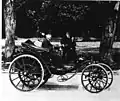 1896 – A . C. Krebs at the steering lever of his system car.
1896 – A . C. Krebs at the steering lever of his system car.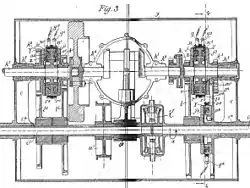 1896 – Electromagnetic gearbox from A. C. Kreb's car patent.
1896 – Electromagnetic gearbox from A. C. Kreb's car patent. 1896 - A. C. Krebs car patent drawing FR256344.
1896 - A. C. Krebs car patent drawing FR256344.
The 1896 Krebs system car (FR256344, GB189619774A) introduced several new features in the car design.
- The three point suspension system generalized (engine and chassis)
since we know that three points are enough to determine a plane.[1]
To these sides [of the frame of the car] I fix or suspend at three points provided with pivoted joints, the motor mechanism which is thereby placed out of the influence of the deformations to which the frame of the car is liable to be subjected during the motion.[2]
- The electromagnetic constant mesh gear box
I had imagined this arrangement to avoid the brutal shocks that the gears undergo when changing gear, a solution that seemed barbaric to me.[3][4]
- The speed shifting at the steering device
For the purpose of operating the electro-magnetic clutch, I employ a commutator arranged preferably under the handle bar and adapted to be operated in such a manner as to establish, according to five different positions, the electrical connections that correspond respectively to: rest; forward movement at low speed; forward movement at medium speed; forward movement at high speed; and movement in the rearward direction.[5]
- The damped steering and the rack and pinion steering gear
Upon the turntable of the fore-carriage is fixed a toothed sector in which engages a pinion mounted on the upper turntable and whose axle carries a toothed wheel situated in a box connected by two tubes to the box of the car. A second toothed wheel mounted on the steering spindle is connected to the first one by means of a chain passing through these two tubes. Elastic rods, consisting for example of coiled springs, are substituted for the links of the chain in the straightportions of the said tuges. By this means the chain is always taut and the springs neutralize the vibrations transmitted to the chain by the jolting of the fore-carriage and so prevent the said vibrations from being transmitted to the steering spindle.[2]
- The forward (positive) caster angle on the steering axis
To ensure the stability of direction by the means of a special arrangement of the fore-carriage, that is to say, to re-establish automatically the parallélism of the two axles of the vehicle when there is no tendency to keep them in any other direction, or after a temporary effort has caused them to diverge from said parallélism; ... The axle of the fore-carriage is situated behind the projection of the axis of the pivot pin in order to ensure the stability of direction above referred to [of a quantity which can vary from 1/7 to 1/8 of the distance which separates the points of contact of the two front wheels with the ground].[2]
- The metallic wheel hub system, Levassor to Krebs:
You would kindly give us permission to use your wheel hub system for which, since you say it is very good, it might be worth patenting.[6][7]
- Aesthetic
The car of Commander Krebs, resulting from very personal and new ideas, has a particular and original aspect. We will add that this aspect is very satisfying and more elegant than any car that we have been allowed to see so far.[1]
The 1898 Voiture Clément-Panhard (VCP) model
 1899-05-06 – The Autocar: "The light Panhard car". The mechanical version of the electromagnetic constant mesh gearbox of the A. C. Krebs system car.
1899-05-06 – The Autocar: "The light Panhard car". The mechanical version of the electromagnetic constant mesh gearbox of the A. C. Krebs system car. 1900 – Clément-Panhard driven by a woman.
1900 – Clément-Panhard driven by a woman..jpg.webp) 1900 - one of the first Spanish vehicles registered in the Balearic Islands.[8]
1900 - one of the first Spanish vehicles registered in the Balearic Islands.[8] 1900 – Mr Herbert Farthing collected his Clément-Panhard (VCP) from the docks at Southampton.[9]
1900 – Mr Herbert Farthing collected his Clément-Panhard (VCP) from the docks at Southampton.[9].jpg.webp) 1927 - The VCP at the first London-to-Brighton veteran car run in November 1927.
1927 - The VCP at the first London-to-Brighton veteran car run in November 1927. 1946 – movie La revanche de Roger la honte: "In 1885. Roger Laroque, a courageous industrialist, is embroiled in a criminal intrigue by the deviousness of his mistress."
1946 – movie La revanche de Roger la honte: "In 1885. Roger Laroque, a courageous industrialist, is embroiled in a criminal intrigue by the deviousness of his mistress."- 1950 – Clément-Panhard driving through Paris.
- 2004 – 1899 Panhard et Levassor – the Clément-Panhard Car (VCP) from A. C. Krebs: "a mechanical nightmare".[9]
In 1896 A. C. Krebs intended to design a car system simple, reliable, aesthetic and secure for beginners. The 1898 Clément-Panhard car inherited the 1896 Krebs patent features, and got new ones.
| Date | VCP patents | Title |
|---|---|---|
| 1897 | FR273374 | The Krebs cone clutch: Improvements to clutches |
| GB189730790A | Improvements in friction couplings | |
| 1897 | FR273375 | The mechanical constant-mesh Krebs gearbox: Improvements to transmissions with speed change |
| GB189730791A | Improvements in speed changing transmission gear | |
| ES22155A1 | A new transmission system, particularly applicable to automatic cars | |
| 1898 | FR284596 | The Voiture Clément-Panhard patent: A petroleum-powered light car system |
| GB189902960A | Improvements in light motor road vehicles |
- The three point suspension system generalized (engine and chassis)
This principle is identical, although the front axle is simpler. With the central pivot axle the intention of A. C. Krebs is double:
- Make the front axle independent of the chassis so as to keep the chassis in a horizontal position even in the event that one of the steering wheels is lifted by an object in its path:
One may wonder why this arrangement, generally considered defective for high-speed cars, was adopted for this cart. This is due to the fact that the manufacturer had above all in view to establish a car of a moderate price, essentially maneuverable, able to make turns on the spot and never having to exceed the speed of 30 kilometers per hour. Under these conditions the steering by rigid axle was perfectly admissible.[10]
- Apply the caster angle principle (see below).
- The mechanical constant mesh gear box
The electromagnetic gearbox is replaced by a mechanical gearbox on the same principle of gears always in mesh. [11]
- The speed shifting at the steering device
The speed shifting is now located on the right side of the car.
- The damped steering and the rack and pinion steering gear
This steering principle is identical, although the rack and pinion system is simpler.
- The forward (positive) caster angle on the steering axis
This steering principle is identical :
The swivel pin extending up from the front, axle for carrying the front end of the vehicle body, is connected to the axle spring by a bracket pivoted horizontally to the spring, and the swivel pin is slightly inclined backward at its upper end so that a downward extension of its axial line will pass at a slight angle in front of the wheel axle. By this arrangement when the front axle has been turned more or less out of its position parallel with the rear axle for lateral steering or turning, and is then released, it will, automatically move-back into the parallel position.[12]
- The metallic wheel hub system
A. C. Krebs generalizes his metallic wheel hub system to the entire Panhard & Levassor range.
- Aesthetic Mr. de Nève said of his VCP in 1950:
It's a small Duke Clément-Panhard of 3 hp. A low, open, two-seater car, engine in the back, well made to show off, with a lady by its side.[13]
- The Krebs cone clutch
The Levassor cone clutch improved by A. C. Krebs (see patent above).
- Engine regulation on admission
A. C. Krebs introduce the engine regulation on admission, instead of the exhaust (see patent above).
- 1899 – The constant level carburetor (FR295792).
- 1900 – The water circulation pump (FR300040).
Engine
%253Dplan_du_chassis.jpg.webp) 1900 – The VCP chassis: The Voiturette Clément-Panhard created by Commander Krebs has the same basic qualities as the big cars built in the factory run by this learned engineer.
1900 – The VCP chassis: The Voiturette Clément-Panhard created by Commander Krebs has the same basic qualities as the big cars built in the factory run by this learned engineer.%253Dle-moteur.jpg.webp) 1900 – The VCP engine.
1900 – The VCP engine. 1900 – The VCP engine block.
1900 – The VCP engine block.%253Dlevier_de_changement_de_vitesse.jpg.webp) 1900 – The VCP gearshift lever.
1900 – The VCP gearshift lever.%253Dorganes_de_commande.jpg.webp) 1900 – The VCP control devices.
1900 – The VCP control devices.
Krebs developed the engine specifically for this vehicle. It is a single cylinder four-stroke engine with originally a bore of 90 mm, a stroke of 120 mm and a displacement of 763cc.
There is no accelerator pedal. The engine always gives its maximum power. At that time the accelerator pedal disengaged the regulator, which was not desirable for a public of beginners. The electric ignition will add a lot of smoothness to the ride (see below).[14]
The engine body is cooled with air, the cylinder head with water. The ignition system consists originally of a burner and hot tube. With the jet carburetor, the engine runs on both petroleum and gasoline. It has 3.5 hp. In the vehicles from 1901, the engine has an output of 4.5 hp and more.
The engine is housed in the rear, standing with a slight backward tilt. The gearbox is a mechanical version of the constant mesh electromagnetic gearbox from A. C. Krebs' 1896 patent. A reverse gear was available from 1899.
Chassis and body
Steel tubing was welded for the chassis, allowing it to be kept light yet strong. The suspension consists of a front transverse leaf spring, which accommodates the vertical steering pin and rotates with the complete front axle when steering, and a pair of longitudinally arranged elliptic springs on the rear axle.
At first there was only a two-seater body as Phaeton. In 1900 variants were added that had a narrow rear-facing seat, making it a three-seater in a vis-à-vis arrangement.
The vehicle weighs 350 kg and 30 km/h is the maximum speed. The first bodies were made of the aluminum alloy called "Partinium".[15]
Steering
The driver sits on the right and steers using a steering wheel. Instead of Ackermann steering A. C. Krebs chose center-pivot steering operated by a gear wheel at the lower end of the steering column and a rack. The device worked satisfactorily on this light and lightly motorized car (see above).
Production
Estimates are from around 500 [16] to around 600 vehicles produced. The first production car was given the engine number 101. Production may have officially ended in 1902, but it cannot be ruled out that a few more copies were made from existing parts by 1903.
Stirling Motor Carriages of Scotland manufactured about 200 vehicles ans sold them in many countries (see below).
New VCP 1901 models
 1901 – Cycles Automobiles Clément – advertisement for Clément-Panhard Cars.[17]
1901 – Cycles Automobiles Clément – advertisement for Clément-Panhard Cars.[17].png.webp) 1901 – Advertising postcards for the Voiture Clément-Panhard (VCP): "What are they waiting for? Ah! it can only be a ... Clément-Panhard car".
1901 – Advertising postcards for the Voiture Clément-Panhard (VCP): "What are they waiting for? Ah! it can only be a ... Clément-Panhard car". 1902 – The Clément-Panhard new model: "6 horsepower engine, electric ignition, wooden wheels, high-speed car."
1902 – The Clément-Panhard new model: "6 horsepower engine, electric ignition, wooden wheels, high-speed car."
In 1901, new features are introduced in the VCPs:
- Both hot tube and electric ignition (from 1900):
The ignition advance lever makes it possible to obtain all the speeds between two speeds of the gear change by suitably varying the engine speed.[14]
The Stirlingmotor VCP models
From 1901 John Stirling buys Clément-Panhard chassis to sell them in many countries with his own bodies.
To prove the robustness of the Clément-Panhards, in July 1901 John Stirling broke the record for crossing the United Kingdom from John-O'-Groat's to Land's End in 59 hours and 15 minutes.[18]
 1901 – VCP Stirling: Parisian Phaeton.
1901 – VCP Stirling: Parisian Phaeton. 1901 – VCP Stirling: delivery van.
1901 – VCP Stirling: delivery van. 1901 – VCP Stirling: miniature brougham
1901 – VCP Stirling: miniature brougham 1901 – VCP Stirling: light dogcart.
1901 – VCP Stirling: light dogcart. 1901 - Stirling light dog-cart.
1901 - Stirling light dog-cart.
The Clément autocycle with removable motor
1901 - At the autoshow, Clément presented an engine set that could be fitted to any bicycle. This engine is derived from the Krebs engine for the Clément-Panhard Car and is dependent on the Panhard & Levassor patents.
 1901 - The Clément autocycle with the removable motor derived from the Krebs engine of the Clément-Panhard Car.
1901 - The Clément autocycle with the removable motor derived from the Krebs engine of the Clément-Panhard Car. 1901 - Advertisement for the Clément autocycle mentioning the dependence on the Panhard & Levassor patents of A. C. KREBS.
1901 - Advertisement for the Clément autocycle mentioning the dependence on the Panhard & Levassor patents of A. C. KREBS.
Technological analogies between the VCP (1898) and the FORD N (1906)
_jm63702.jpg.webp) 1900 - Clément-Panhard (VCP) Phaeton.
1900 - Clément-Panhard (VCP) Phaeton. 1906 - Ford model N.
1906 - Ford model N.
It should be noted the many similarities in principle between the Clément-Panhard car of 1898 (see above) and the Ford model N of 1906, forerunner of the Ford model T:
- Intended for the general public;
- Solid and safe;
- Generalization of the suspension by 3 points and triangulations;
- Transverse spring on the front axle, so the VCP waddles as does the Ford T;
- A quasi-automatic gearbox etc.
Also the use of vanadium steel by Ford comes from a Panhard & Levassor racing car that crashed during a race in America.[19]
The surviving and famous VCP cars
_photo_2.jpg.webp) Side view of the 1900 Clément-Panhard Phaeton (VCP), 765cc 3,5cv, achieving a top speed of 35kmh.
Side view of the 1900 Clément-Panhard Phaeton (VCP), 765cc 3,5cv, achieving a top speed of 35kmh._photo_5.jpg.webp) The 1900 Clément-Panhard Phaeton (VCP).
The 1900 Clément-Panhard Phaeton (VCP)._photo_6.jpg.webp) Front view of the 1900 Clément-Panhard Phaeton (VCP).
Front view of the 1900 Clément-Panhard Phaeton (VCP).
According to a website specializing in this model, 17 vehicles still exist.[9]
| specified year of construction | Exhibition place | Chassis no. | engine no. | Vehicle UK registration number | Picture |
|---|---|---|---|---|---|
| 1899 | Sparreholms Motormuseum Sparreholm, Sweden | 141 | 195 | IY 45 | 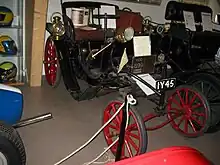 |
| 1899 | United Kingdom | 210 | 201 | V 46 | 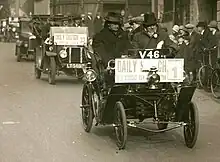 |
| 1899 | United Kingdom | 171 | PX 98 | This car was part of the French collection of Henri Malartre displayed at the Chateau de Rochetaillée near Lyon (France). | |
| 1899 | Museo Nazionale dell'Automobile Turin | 260 | Clement-Panhard 3 HP, 1899 | ||
| 1900 | United Kingdom | 244 | 356 | AH 48 |  |
| 1900 | United Kingdom | 366 | 166 | FX 149 | Has been in the Norwood family since 1970.[9] |
| 1900 | United Kingdom | 238 | 238 | BS 8237 | Rebuilt by Arthur Livingstone in the UK in the 1980s. |
| 1900 | James Hall Transport Museum in La Rochelle, Johannesburg, South Africa | 328 | 328 | 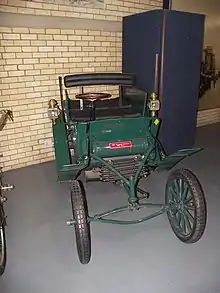 | |
| 19xx | Riverside Museum Glasgow, Scotland | 539 | 419 | HD 68 | "Josephine" was discovered in the early 1930s and took part in the 1938 Brighton Run.[21] |
| 1900 | Cité de l'Automobile Mulhouse, France | 469 | _photo_2.jpg.webp) | ||
| 1901 | France | 448 | A 57 | 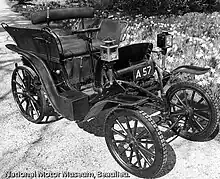 | |
| 1901 | Netherlands | Took part in the 1966 London to Brighton Run (#56), the entrant was Mr. A. Janssen from Holland. | |||
| 1902 | Museums Collections Centre Birmingham, England | O 65 | .jpg.webp) | ||
| 1900 | United Kingdom | 577 | 462 | BS 8010 | 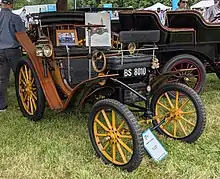 |
| 1900 | Alsace, France | 264 | 11 ZT 67 | Mr. Reithoffer restored a Clément-Panhard that he acquired as a wreck in 1989. thumb | |
| 1900 | Museu da Misericórdia Salvador, Brasil | 475 |  | ||
| 1900 | Tallinn, Estonia |  | |||
| 1901 | 313 | From the 1940s this car was in the Lindley Bothwell collection in the US. | |||
| 1900 | Palma de Mallorca, Spain | PM1 | .jpg.webp) First car to be registered in Spain in Palma de Mallorca with the registration PM1.[8] | ||
| ? | 581 | Engine only : discovered in a barn in Southern England in 2011. A whole car has now been built around this engine. | |||
| 1901 | 1901 Model. | ||||
| 1901 | 1901 Model in blue: Front, Rear. |
Documentation
- Bernard Vermeylen: Panhard & Levassor: Entre tradition et modernité. E-T-A-I, Boulogne-Billancourt 2005, ISBN 2-7268-9406-2.
References
- La France Automobile, La Voiturette Krebs, 1896 p.305, by Louis Lockaert, ingénieur École Centrale of Paris.
- GB189619774A
- 1924-06 – Autobiographic letter from Arthur Constantin Krebs to his cousin General de Montluisant (SHD-DE-2014-PA-40) asking him to explain his career following the article by Paul Renard in the "Revue Aéronautique" about the 40 years of the dirigible "La France" (Krebs arch.).
- The Krebs electromagnetic constant mesh gear box
- Krebs speed control on the steering wheel
- The Krebs metallic wheel hub system
- 1896-09-03 – Emile Levassor license letter addressed to Arthur Constantin Krebs on his patent FR256344 (GB189619774A) for a motor car.
- https://www.bolsamania.com/kmph/pm-1-el-primer-coche-matriculado-en-espana/
- Site: Clément-Panhard on the web.
- 1900-Automobiles at the 1900 Exhibition [by Commander Ferrus and Captain Genty]. Extract from the Commission's report.
- GB189730791A
- GB189902960A
- Partinium: "High strength extra light alloy".
- La Voiturette Krebs At rbmn.free.fr, accessed 24 April 2022.
- 1901 Cycles Automobiles Clément – advertisement for the Clément-Panhard Car (VCP) designed by A. C. Krebs
- 1923 – Henry Ford My Life and Work: "In 1905 I was at a motor race at Palm Beach, There was a big smash-up and a French car [a Panhard racing car] was Wrecked. We had entered our 'Model K' — the high-powered six. I thought the foreign cars had smaller and better parts than we knew anything about. After the wreck I picked up a little valve strip stem. It was very light and very strong. I asked what it was made of. Nobody knew. I gave the stem to my assistant. 'Find out all about this,' I told him. 'That is the kind of material we ought to have in our cars.' He found eventually that it was a French steel and that there was vanadium in it. We tried every steel maker in America — not one could make vanadium steel. I sent to England for a man who understood how to make the steel commercially. The next thing was to get a plant the United Alloy Steel of Canton, Ohio to turn it out."
- "Motor Cars – Veteran, Vintage and Classic | The James Hall Museum of Transport". jhmt.org.za. Retrieved 2023-03-09.
- "Josephine" from gracesguide.co.uk, retrieved 24 April 2022.
- Estonia
External links
- 1901 – 1898 and 1901 VCP versions exposed at the Clément stand at the Paris Motor Show. Panhard-Levassor Light Two-Passenger Car.
- 1901 – The Stirling cars: The light car De Luxe, the John O' Groater.
- 1901 – "The record for crossing England from the North to the South West, from John O' Groats to Land's End, has just been beaten by M. J. Stirling. Leaving on July 30 in the morning from John O' Groats, he arrived 59 hours later at Land's End which is 847 miles from the start."
- 1901 – Automobiles in the Glasgow International Exposition: Stirling Parisian Phaeton
- 1902 – The Stirling Miniature Brouham, the 1902 Stirling Light Dogcart.
- 1902 – The Stirling Light Delivery van: "Simple, Reliable, Attractive, Economical, Expeditious." – The Stirling Parisian Phaeton: "Up-to-date, the fashionable light car, can be driven by a Lady".
- 1902 – The 1902 Stirling Light Dogcart: "Up-to-date, latest improvements".
- 1902 – "If you value your life ... don't buy an Experimental or untried car."
- 1904 – Self-propelled vehicles.
- La Voiturette Krebs from rbmn.free.fr.
- Clément-Panhard on the web.